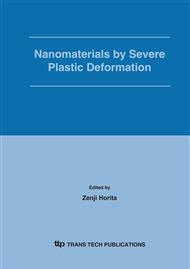p.407
p.413
p.419
p.425
p.433
p.439
p.447
p.455
p.461
3D-Atom Probe Investigation of Vacancy Induced Interdiffusion during High Pressure Torsion Deformation
Abstract:
Concentration gradients resulting from long range diffusion during Severe Plastic Deformation (SPD) have been investigated with the 3D Atom Probe technique (3D-AP). First, in a pearlitic steel where alloying elements (Mn, Si and Cr) are partitioned between the ferrite and carbides in the non-deformed state. After processing by High Pressure Torsion (HPT), they are homogeneously distributed in the nanostructure, indicating that long range diffusion occurred along with the dissolution of carbides. 3D-AP data of a Cu-Fe composite processed by HPT show as well a significant interdiffusion of Cu and Fe, probably promoted by additional vacancies. On the basis of these experimental data, and using the theory described for irradiated materials, vacancy fluxes and vacancy production rates were estimated assuming that new vacancies are continuously produced and eliminated on grain boundaries.
Info:
Periodical:
Pages:
433-438
Citation:
Online since:
January 2006
Authors:
Keywords:
Price:
Сopyright:
© 2006 Trans Tech Publications Ltd. All Rights Reserved
Share:
Citation:


